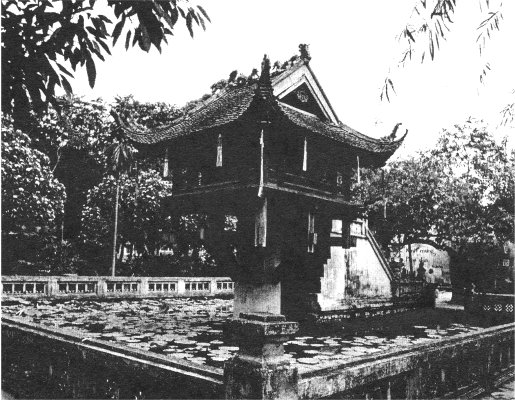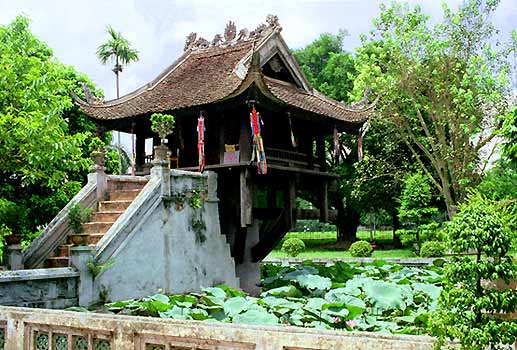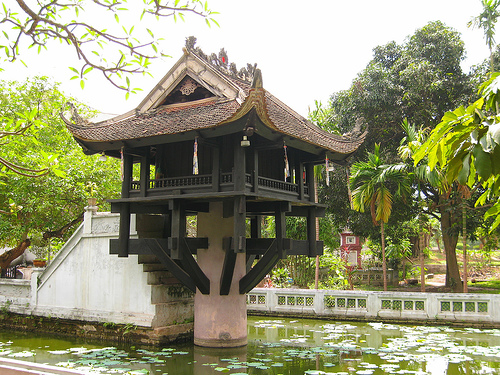One Pillar Pagoda (Chua Mot Cot) has become one of the most delightful architectural complexes in Hanoi, attracting a large number of domestic and foreign tourists in Vietnam Travel
The legend of One Pillar Pagoda
According to legend, ageing Emperor Ly Thai To of the Ly dynasty, who had no children, used to go to pagodas to pray to Buddha for a son. One night, he dreamt that he was granted a private audience to the Bodhisattva Avalokiteshvara, who was seated on a great lotus flower in a square-shaped lotus pond on the western side of Thang Long Citadel, gave the King a baby boy. Months later, when the Queen gave birth to a male child, the Emperor ordered the construction of a pagoda supported by only one pillar to resemble the lotus seat of his dream in the honour of the Bodhisattva Avalokiteshvara. According to a theory, the pagoda was built in a style of a lotus emerging out of the water.

History of One Pillar Pagoda
In the past, One-Pillar Pagoda was located in Thanh Bao Village, Quang Duc District in the west of Thang Long Citadel under the Ly Dynasty. According to Dai Viet Su Ky Toan Thu (A Complete History of Great Viet), the pagoda was built in the winter of 1049 under the reign of King Ly Thai Tong who dreamt of seeing the Goddess of Mercy sitting in a lotus throne and taking him to it. When waking up, the king told mandarins about his dream and one of them thought that it was a bad omen. Monk Thien Tue advised him to build a pagoda and a lotus-shaped tower like what he saw in his dream. When the pagoda was inaugurated, monks went around the pagoda and recited the Buddhist scriptures to pray for longevity of the king. For this reason, the pagoda is also called Dien Huu (long lasting happiness and good luck).

One Pillar pagoda - HaNoi
During the Ly Dynasty, the pagoda was the site to hold an annual ceremony on the occasion of Buddha Day - Vesak. In addition, on the 8th day of the 4th lunar month, the king and people visited the pagoda to participate in Buddha-bathing and release ceremonies.
After being repaired many times, the pagoda was destroyed by the French colonists in 1954. In 1955, the government has the pagoda rebuilt. The present wood pagoda is in the shape of square with each side of 3m and a curved roof. It was designed to resemble a lotus stretching up out of the square pond and placed on a big stone pillar including two blocks which are connected together skillfully. This stone pillar is approximately 4m high (excluding the underground section) and 1.2m in diameter. The pagoda structure also shows the harmonious combination of imagination and unique architecture with a system of wood beams that create the solidity and beauty for the pagoda.

With its architectural and historical values, the One-Pillar Pagoda was classified as a historical relic on April 28, 1962. On May 4, 2006, it was recorded in the Vietnamese Guinness Book as The pagoda with the most unique architecture in Vietnam.
Nowadays, One pillar pogoda has become one of the most delightful architectural complexes in Hanoi, attracting a large number of domestic and foreign tourists. The pagoda is open daily from 8h00 a.m. to 5h00 p.m. Entrance is free.
If tourists in Vietnam Travel have chance to visit Hanoi, One pillar pagoda is a must-see place that should not be missed!
www.vietnamtourism.org.vn
(84-63) 3 826042 – (84-63) 3 511142
No 54 Nguyen Dinh Chieu, Ham Tien Central Mui Ne Beach Binh Thuan Vietnam
523 To Hien Thanh District 10 Ho Chi Minh City Vietnam
Ha Long Halong City Quang Ninh Vietnam
A13 Hung Thong 2 Halong City Quang Ninh Vietnam




